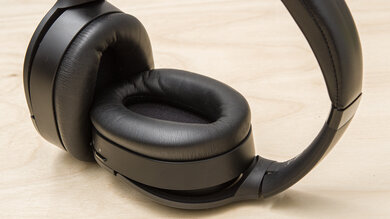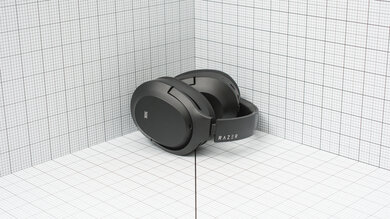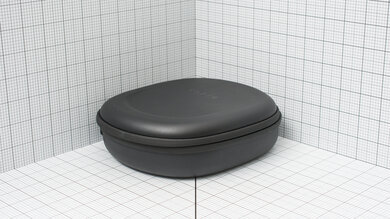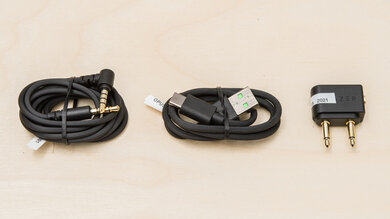The Razer Opus Wireless 2021 are the stealth version of the Razer Opus Wireless 2020. Without any announcements, Razer quietly replaced their 2020 model with this variant. The differences in packaging and marketing between both models can be hard to catch: the manufacturer has updated the Bluetooth version from 4.2 to 5.0 and removed aptX codec support, which offers better audio quality. That said, although they otherwise look nearly identical to their predecessor, they don't perform quite similarly and are a slight step down from the original model. Their sound profile is warmer, and their noise cancelling system doesn't block out nearly as much background sound. On the upside, they now offer a 'Gaming Mode' for low latency, which is good if you like to stream video or play games on your mobile device. Their continuous battery life is much longer too.
If you'd like to know which variant of these headphones you have, Razer provides instructions on how to check your unit's serial number on their support page, under the 'FAQs' tab.
Our Verdict
The Razer Opus Wireless 2021 are good for neutral sound. Using their 'THX' EQ, they have a warm sound profile that delivers extra boom and warmth. That said, while vocals and lead instruments sound clear and accurate, their upper harmonics are veiled, while sibilants are dull. The headphones also lack low-bass, so if you like listening to genres like EDM and hip-hop, your mixes lack thump and rumble. While you won't get a flatter, more neutral sound using the EQ presets in their companion app, they're still worth using if you want a different sound.
- Comfortable and well-built design.
- EQ presets available.
- Closed-off passive soundstage.
The Razer Opus Wireless 2021 are great for commute and travel. They have a comfortable, well-built design and come with a carrying case to help protect them when you're on the go. They also have a very long continuous battery life that can last through long plane rides without an issue, and they have an active noise cancelling (ANC) system to help block out the low rumble of bus and plane engines. Their ANC can isolate you from passenger chatter too.
- Comfortable and well-built design.
- Long-lasting continuous battery life.
- ANC blocks out an excellent amount of ambient noise.
- Closed-off passive soundstage.
The Razer Opus Wireless 2021 are decent for sports and fitness. While over-ear headphones can be a bit bulky, and their design tends to trap heat around your ears, the Razer have a comfortable and stable fit that's worth considering for light to moderate workouts. They also have a great build quality, and their wireless design makes it difficult for something to snag the headphones off your head while moving.
- Comfortable and well-built design.
- Closed-off passive soundstage.
The Razer Opus Wireless 2021 are good for office use. They have a comfortable and well-built fit. Their long continuous battery life means you can use them for a few days in a row before recharging them. Unfortunately, they don't support multi-device pairing, which is disappointing if you want to stay connected to your smartphone and PC at the same time. If you're using these headphones for virtual meetings, you can also experience a dip in sound quality when using the mic and audio simultaneously. However, this isn't an issue with the headphones per se but is one of the limitations of Bluetooth.
- Comfortable and well-built design.
- Long-lasting continuous battery life.
- ANC blocks out an excellent amount of ambient noise.
- Mic has mediocre noise handling.
- No multi-device pairing.
The Razer Opus Wireless 2021 are Bluetooth-only headphones, so they aren't compatible with Xbox or PlayStation consoles. While you can connect them to a Bluetooth-enabled PC, the latency will likely be too high for gaming. That said, they're worth considering if you're interested in mobile gaming as they have a low latency mode to lower the risk of audio syncing issues.
The Razer Opus Wireless 2021 are good for wired gaming. You can plug them into your console's controller using the 1/8" TRRS cable with full audio and mic compatibility. Their warm sound profile can help emphasize sound effects like footsteps in gameplay, while their neutral mid range ensures that dialogue and lead instruments sound clear. Their mic also offers fair recording quality. Your voice sounds clear, but lacks depth.
- Comfortable and well-built design.
- Closed-off passive soundstage.
- Mic has mediocre noise handling.
The Razer Opus Wireless 2021 are fair for phone calls. They have an integrated mic that doesn't sit very close to your mouth. While the mic can capture your voice clearly, it struggles to separate speech from ambient sound. If you're taking a call from a busy office, your voice can be drowned out. In addition, if you're making a conference call, audio quality can drop, which is normal as it's a limitation of Bluetooth. On the upside, their ANC system can help block out an excellent amount of ambient noise around you.
- Comfortable and well-built design.
- ANC blocks out an excellent amount of ambient noise.
- Mic has mediocre noise handling.
- No multi-device pairing.
Changelog
- Updated Dec 21, 2023: We have updated the Battery text to clarify our 'Audio While Charging' results.
- Updated Feb 06, 2023: We've retested these headphones using FW 1.3.1.0 and with the 'THX' preset enabled. All tests within Sound, Noise Isolation, and Microphone have changed. We've also updated Test Settings and uploaded a new App Support image to better reflect the app's capabilities.
- Updated Jul 11, 2022: We've retested 'Virtual Soundstage'. They have a THX feature available in the companion app, but we don't consider this a virtual soundstage feature as it acts more as an EQ preset. We have updated the text and the scoring of this box has changed.
- Updated May 10, 2022: We've looked into user reports of the volume lowering when gaming on an Xbox console using the following settings: wired, with the headphones on, and ANC on. The max volume we reached using this setting on our Xbox console is lower than when used wirelessly or when listening to non-game audio files on the Xbox. You can find more detail about our testing process in 'Xbox Compatibility'.
Check Price
Differences Between Sizes And Variants
The Razer Opus Wireless 2021 come in two color variants: 'Black' and 'Razer x *A Bathing Ape', which is a black variant with a green snake-like print. We tested the Black variant, and you can see our model's label here. These headphones are the updated stealth variant of the Razer Opus Wireless 2020. If you want to check which version you have, Razer has instructions on how to check their serial number via their support page in the 'FAQs' tab.
If you come across another variant of these headphones, please let us know in the discussions, and we'll update our review.
Popular Headphones Comparisons
The Razer Opus Wireless 2021 are the updated variant of the Razer Opus Wireless 2020. While they have a similarly comfortable and sleek design, their ANC's noise isolation performance is a slight step down from their predecessor. That said, the ANC still blocks an excellent amount of ambient sound. They're also better built than the AKG N700NC M2 and have a long-lasting continuous battery life. Their warm sound profile with rolled-off treble is well-suited for genres like jazz, but if you're looking for a more neutral sound from Razer, you'll want to check out the Razer Opus X Wireless.
Check out our recommendations for the best wireless Bluetooth headphones, the best noise cancelling headphones, and the best headphones for music.
The Razer Opus Wireless 2021 are the stealth update of the Razer Opus Wireless 2020 and there have been some downgrades in performance. While both headphones have a similarly comfortable and well-built design, the 2020 variant have a much more neutral sound profile, which some users may prefer, and their noise isolation performance is better. They also support aptX codec, which is nice if you're looking for better audio quality via Bluetooth. That said, the 2021 have a 'Gaming Mode' for a lower latency audio experience.
The Sony WH-1000XM4 Wireless are better over-ears than the Razer Opus Wireless 2021. The Sony are more comfortable, have a significantly better noise isolation performance, and have a companion app offers a graphic EQ and presets to help you adjust their sound to your liking. They also support multi-device pairing, which is good if you want to stay connected to your PC and smartphone at the same time. However, the Razer have a more immersive passive soundstage performance.
The Razer Opus Wireless 2021 are slightly better headphones than the Razer Opus X Wireless. While both headphones are comfortable, the Opus are better-built, have a better noise isolation performance, and support passive playback. They also come with a carrying case and have better frequency response consistency. However, you may still prefer the Opus X if you're looking for more colorful headphones at a lower price point.
The Bose QuietComfort 35 II/QC35 II Wireless 2018 are better headphones than the Razer Opus Wireless 2021. The Bose are more comfortable, have a neutral sound profile, which some users may prefer, and their ANC offers a significantly better noise isolation performance. They also support multi-device pairing, meaning you can stay connected to your PC and smartphone at the same time. However, the Razer are better-built.
Test Results

The Razer Opus Wireless 2021 have a nearly identical design to the Razer Opus Wireless 2020. They have oval-shaped ear cups with a fairly non-descript look. Like other casual use Razer headphones, they also lack Razer's usual gaming logo. However, the only thing that has changed in terms of design is that their controls are now only located on the right ear cup instead of on both ear cups. They come in two colors: 'Black' and 'Razer x *A Bathing Ape', which is a black and green colorway.
The Razer Opus 2021 have a comfortable fit. Like the Razer Opus Wireless 2020, they have good padding on the ear cups and headband. They also don't put too much pressure on your head and feel lightweight. However, they have somewhat shallow ear cups, so if you have large ears, they may get squished.
The Razer Opus Wireless 2021 have a good control scheme. Unlike the original Razer Opus Wireless 2020, all the controls are located on the right ear cup. They have dedicated volume up and down buttons that you can press and hold to continuously increase the volume. Each of the buttons are clicky and the multi-function button has an indentation so that it's easy to distinguish it from the volume buttons. There are also audio prompts when cycling between different ANC settings and there's a chime to let you know when you've reached max volume.
Multi-function button:
- Single press: Plays and pauses audio. Also answers and ends calls. You can even put a call on hold.
- Press and hold for two seconds: Accesses voice assistant. Also rejects incoming calls and if you're currently on a call, swaps to another on-hold call.
- Press and hold for five seconds: Enables and disables 'Game Mode', which is a mode that helps lower latency.
- Double press: Skips the track forward.
- Triple press: Skips the track backward.
Power button:
- Single press: Cycles between ANC on, ANC off, and ambient mode, which allows you to better hear your surroundings without taking off your headphones.
- Press and hold: Turns the headphones on and off.
The Razer Opus Wireless 2021 come with a great carrying case that'll protect the headphones from scratches, bumps, and water damage. There's a space inside the case to store the cables when not in use. While it's a bit bulky, it'll fit into a backpack without an issue.
The Razer Opus Wireless 2021 have a great build quality. The only difference between this model and the Razer Opus Wireless 2020 in terms of build is that the controls are only located on the right ear cup. They're mostly made out of plastic with faux leather padding. However, they feel like they could survive a couple of accidental drops without taking too much damage.
Using the default 'THX' EQ, the Razer Opus 2021 have a warm sound profile with a touch of extra boom and rolled-off treble to ensure a smooth sound. They differ from the original Razer Opus Wireless 2020, which sound more neutral and less bass-heavy. Luckily, if you prefer a different sound, their companion app offers a few EQ presets to help you find the right sound for your needs.
The Razer Opus Wireless 2021 have very good frequency response consistency. While they're prone to deviations in bass and treble delivery due to fit, seal, and positioning, it's very minor. Once you achieve a good fit, you will experience more consistent audio delivery.
These headphones have excellent bass accuracy. The low-bass is fairly flat, which results in adequate thump and rumble. The rest of the range is slightly overemphasized, resulting in a bit more kick and warmth that will please fans of EDM and hip-hop.
The Razer Opus Wireless 2021's mid-accuracy is excellent. The entire range is overemphasized, although the low to mid-mid is still fairly neutral. The high-mid has a larger bump, making vocals and instruments sound a little honky. In songs like As It Was by Harry Styles, vocals sound clear and accurate but also a little harsh.
The Razer Opus Wireless 2021 have satisfactory treble accuracy. The range is uneven and underemphasized. Vocals and lead instruments are very veiled, so in songs like Wait a Minute! by WILLOW, her voice lacks detail and presence throughout the mix. Sibilants like cymbals are also slightly dull.
The Razer Opus 2021's peaks and dips performance is fair. A dip in the low-bass weakens thump and rumble in your mix, while a small peak in the high-bass adds extra warmth. The following dip in the low-mid slightly weakens vocals and instruments, then a peak in the high-mid makes vocals and lead instruments harsh. The uneven low-treble hurts their comprehensibility overall. Another uneven peak and dip in the mid-treble makes sibilants like S and T sounds alternatingly dull and piercing.
The Razer Opus Wireless 2021's imaging performance is great. The group delay response falls below the audibility threshold, which results in tight bass and transparent treble reproduction. The L/R drivers are also well-matched in terms of phase, amplitude, and frequency response, which is important for the accurate placement of objects like instruments in the stereo image. While there's a peak in the phase response's low-mid, which skews audio a bit to the left, it's not audible with real-life content. Imaging can vary between units and can indicate a manufacturer's quality control and ergonomics.
The Razer Opus Wireless 2021's passive soundstage performance is poor, which is common among closed-back headphones. It feels somewhat unnatural, and it lacks openness as well as spaciousness. Despite this, the soundstage also seems wide, and sound is perceived as coming from speakers placed in the room around you rather than from inside your head, which can make for a somewhat more immersive audio experience.
Like the Razer Opus Wireless 2020, these headphones are THX-certified via the companion app. However, this isn't a virtual soundstage feature, but an EQ preset, which you can use to help create a more immersive sound. You can also turn this feature on and off in the app. That said, this feature isn't THX Spatial Audio, which is a separate downloadable application.
The Razer Opus Wireless 2021's weighted harmonic distortion performance is good. There are a couple of peaks starting in the high-mid, which can result in slightly less clear and pure audio reproduction. However, this can be hard to hear with real-life content.
These are the settings used to test the Razer Opus Wireless 2021. Our results are only valid when used in this configuration. Some users have also reported that after updating to FW 1.3.1.0, they can reach lower volume levels than with previous firmware. We also noticed this during testing, but since we didn't initially test for it, we don't know how much of an impact this change had.
The Razer Opus Wireless 2021's noise isolation performance is excellent. They can block out the low rumble of bus engines well. They do an excellent job of blocking out ambient chatter and the high-pitched hum of an AC unit, although their performance still falls a bit short compared to the Razer Opus Wireless 2020.
The Razer Opus Wireless 2021's leakage performance is great. Leakage is concentrated across the range and sounds fuller than in-ear headphones. That said, if you're listening to audio at high volumes, it's unlikely for others to hear it if you're in a moderately noisy environment like a busy office.
The Razer Opus Wireless 2021's integrated mic has a fair recording quality. Your voice sounds fairly natural but lacks depth.
These headphones are Bluetooth and rely on Bluetooth profiles, which define the specifications for how data is communicated between devices. When you connect these headphones to your PC, they use Advanced Audio Distribution Profile (A2DP), a Bluetooth profile for audio playback. A2DP is a one-way profile, which means that if you're using this profile, the mic won't work on any device or OS. If you want mic and audio compatibility, the headphones can enable Headset Profile (HSP) or Hands-Free Profile (HFP). However, both profiles can lower sound and mic quality. During a conference call, we noticed that audio quality dropped a lot. Your voice becomes pitchy, and all the bass is lost, so speech lacks body.
The microphone's noise handling performance is mediocre. The mic has a difficult time separating your voice from moderate ambient noise around you, so if you're taking a call from a busy street, your voice can be drowned out.
The Razer Opus Wireless 2021's battery performance is outstanding. They're advertised to last 30 hours continuously and with their ANC on. We measured over 52 hours, which far exceeds our expectations, but matches the high discrepancy also seen in the Razer Opus X Wireless. We also verified that the volume was maxed out on both our headphones and the test phone.
These headphones are equipped with an auto-off timer to help conserve battery life when you're not using them. You can adjust the length of the timer via the companion app. There's also an 'Auto-Pause/Resume' feature that you can use to pause the headphones if you take them off of your head. Keep in mind that you can use these headphones while they're charging, but the USB cable itself doesn't support audio; instead, the headphones still use Bluetooth for audio playback while charging. You won't be able to use these headphones via analog while also charging.
The Razer Audio app is decent. You can check out the battery life, turn on and off the 'Auto Pause/Resume' feature, as well as adjust the auto-off timer. There are also four EQ presets that you can use to adjust their sound: 'Amplified', 'Enhanced Bass', 'Enhanced Clarity', and 'Vocal'. You can even turn on and off the THX preset for a more immersive audio experience.
The Razer Opus Wireless 2021 have okay Bluetooth connectivity. Unfortunately, they don't support multi-device or NFC pairing. Unlike the Razer Opus Wireless 2020, they don't support aptX codec for better sound quality either. They also have somewhat high latency on PCs as well as on iOS and Android devices. That said, they're equipped with a 'Gaming Mode' that helps lower latency and ensures that your audio and visuals stay in sync. With this mode on, there's 98 ms of latency on PC, 112 ms on iOS, and 90 ms on Android. Note that some devices and apps compensate for latency though.
The Razer Opus Wireless 2021 can connect to PCs via Bluetooth with full compatibility. You can also receive full audio and mic support when using their 1/8" TRRS cable.
The Razer Opus Wireless 2021 can only be used on PlayStation consoles when you plug in their analog cable into your controller. That said, you'll receive full audio and mic support via this connection.
The Razer Opus Wireless 2021 can only be used via analog with your Xbox console. Once you've plugged their 1/8" TRRS cable into your controller, you'll receive full audio and mic compatibility.
Some users have reported experiencing issues with the headphones' max volume when connected to their Xbox console. We connected our headphones to an Xbox Series S and played a game to measure the volume. When powered off, they reached 84 dB. Turning the ANC on lowered their volume to 75 dB. With the headphones on, but the ANC off, the headphones reached 71 dB. We tried the same settings with an audio file on a USB drive. When powered off, we could reach 107 dB, but ANC on lowered the volume to 103 dB. With ANC off, the headphones reached 99 dB. To confirm our results, we also tried the same audio file on a PC with the headphones connected wired and wirelessly. We experienced similar results to our pass with the USB drive but could reach higher volumes wirelessly.
Overall, we consistently experienced a drop in volume when the headphones were turned on, but the ANC was off. However, the difference is most noticeable on Xbox consoles, as the volume of the game is much lower than when using the headphones wirelessly or using them wired with the power off. The headphones can also reach a volume similar to their wireless performance when playing non-game audio files on the Xbox. We don't currently know what's causing this, but if you experience this issue, please let us know in the discussion section below.















